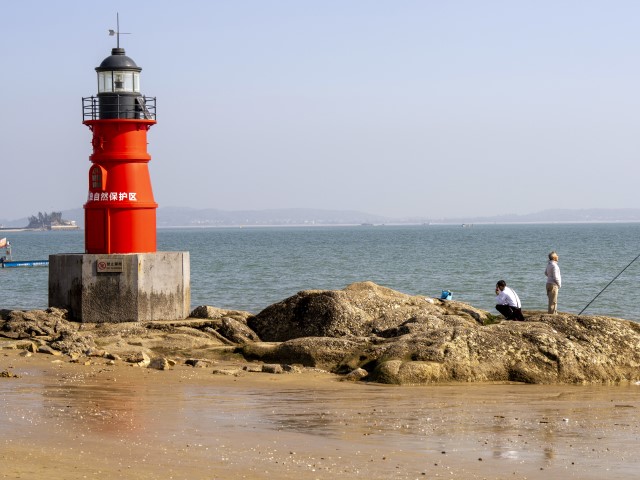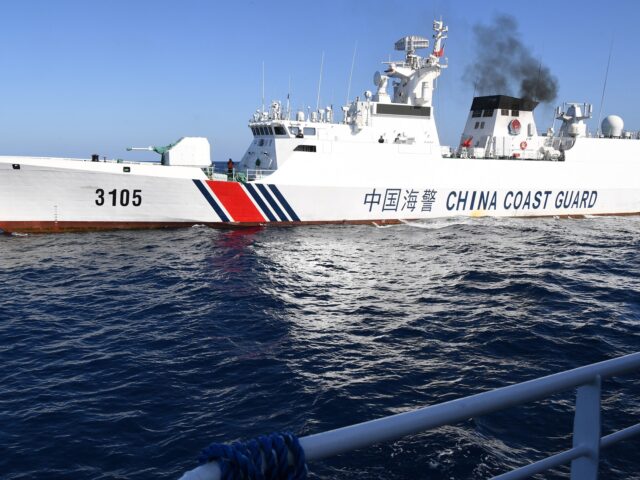The Chinese Coast Guard escalated its presence around the Kinmen Islands near Fujian province on Monday in response to an incident on February 14 in which Taiwanese authorities reportedly chased away a Chinese “fishing” vessel, causing it to capsize and killing half the men on board.
The Kinmen Islands are located about 4 miles from the Chinese province of Fujian and close to 190 miles from Taipei, the capital of Taiwan. The Taiwanese government claims them as part of its territory, establishing “prohibited” and “restricted” water in which it bans Chinese vessels entirely or reserves the right to expel them, respectively.
The Taiwanese Mainland Affairs Office, the federal government agency responsible for relations with communist China, insisted following the incident on Wednesday that it was necessary because China has increased the intimidating presence of purported “fishing” ships and other vessels in waters that Taiwan claims as its own, including a growing number of ships that have no name and no formal registration, making it impossible for Taiwanese authorities to ensure they are not a threat.
Singapore-based Channel News Asia (CNA) reported on Monday that at least four Chinese Coast Guard ships appeared to be operating around the Kinmen Islands. The Coast Guard had announced the day before that it would increase patrols in the area in response to what it claimed to be Taiwanese belligerence.

People sit on a beach in front of Kinmen island on Friday, Jan. 5, 2024. (Raul Ariano/Bloomberg via Getty)
The Chinese “Taiwan Affairs Office,” the Beijing counterpart to the Mainland Affairs Council, condemned Taiwan on Sunday for having a “terrible attitude” and appearing to display “indifference to the lives of people on the mainland [China].” China’s state-run Global Times claimed that the response to the suspicious vessel that capsized on February 14 – described by different reports as a “speedboat” or a “fishing vessel” – was particularly offensive because Taiwan allegedly “often turns a blind eye to the Japanese fishing vessels sailing into waters near Taiwan, which sharply contrasts with how Taiwan authorities violently expelled the mainland fishing boat.”
“The recklessness of the DPP must be corrected and counteracted, and justice and fairness in the Taiwan Straits must be maintained,” the state propaganda mouthpiece demanded.
Taiwan, formally the Republic of China, is a sovereign state off the coast of China. China does not recognize its existence despite its longstanding democratic institutions and Beijing’s lack of authority over the island nation, instead falsely claiming Taiwan as a rogue “province” and its elected government as a nefarious “separatist” entity. The Communist Party of China claims all the sovereign maritime territory of Taiwan for itself.
On Wednesday, multiple reports indicated, the Taiwanese Coast Guard found the suspicious vessel and approached it, reportedly to keep it out of “restricted” Kinmen Islands waters. The chase began when, rather than engage with the Coast Guard, the ship attempted to flee an inspection. Four men were reportedly on board; all fell into the water when the ship capsized. Two of them died; the other two remain in Taiwanese custody at press time.
The Taiwanese Mainland Affairs Council issued a statement lamenting, “Nobody wants to see incidents occur,” but ensuring that Taipei would cooperate with the families of the boat’s crew and dismissing Chinese government accusations against the nation as “groundless.”
“Our authorities will expel or detain vessels crossing our border, in accordance with the law. This has been the case in the past, and [they] will continue to enforce the law in the future,” the Council asserted. “We call on both sides to cooperate with each other, to clarify the cause of the incident and to devise ways to cooperate moving forward, which would benefit people on both sides of the Taiwan Strait.”
The Global Times reported on Monday that Taiwan would accept representatives of the families of the boat’s crew, along with the Red Cross, to travel to the Kinmen islands and extract the two living crew members. Chinese authorities did not offer a specific time frame for the operation to free the men.
In addition to Taiwanese waters, the Chinese government claims maritime territory belonging to Vietnam, Malaysia, Brunei, and the Philippines, using a false border known as the “nine-dash line.” The Permanent Court of Arbitration at the Hague ruled China’s territorial claims invalid in a landmark 2016 decision.
China has dramatically exacerbated tensions in the South China Sea in the past decade with the illegal construction of apparently military assets on artificial islands in waters within the “nine-dash line,” particularly near the Spratly and Paracel Islands, where the Philippines and Vietnam assert sovereignty. In 2022, U.S. Indo-Pacific commander Adm. John C. Aquilino told the Associated Press that at least three artificial islands in the region boasted Chinese “missile arsenals, aircraft hangars, radar systems and other military facilities.”
“The function of those islands is to expand the offensive capability of the PRC [China] beyond their continental shores,” the admiral said. “They can fly fighters, bombers plus all those offensive capabilities of missile systems.”
In addition to militarizing the region, China has attacked Vietnamese and Philippine ships navigating their own territorial waters. In a particularly violent incident in 2019, a Chinese ship rammed a Philippine fishing vessel in Philippine waters, destroying it and leaving the 22 crewmen on board to drown. The men survived only after a Vietnamese ship appeared and rescued them. The Philippine government called the incident “barbaric,” but did little to retaliate.
A year later, China sank a Vietnamese fishing boat in Vietnamese waters, this time “capturing and detaining the crew,” according to local Vietnamese official Nguyen Van Hai.
More recently, Philippine authorities accused China of attacking a Philippine supply ship with a water cannon in August, an “excessive and offensive action” attempting to prevent the ship from accessing the Second Thomas Shoal, a Philippine territory within the illegal “nine-dash line.”

In this handout photo provided by the Philippine Coast Guard, a Chinese coast guard ship uses water canons on a Philippine Coast Guard ship near the Philippine-occupied Second Thomas Shoal, South China Sea, as they blocked its path during a resupply mission on Saturday, August 5, 2023. The Philippine military condemned on Sunday a Chinese coast guard ship’s “excessive and offensive” use of a water cannon to block a Filipino supply boat from delivering new troops, food, water and fuel to a Philippine-occupied shoal in the disputed South China Sea. (Philippine Coast Guard via AP)
Manila increased its naval presence on Friday around Palawan Island, another area illicitly claimed by China, in an attempt to send “a reminder to all who would dare challenge our sovereignty that we stand ready and vigilant,” Philippine Commodore Edward Ike De Sagon said.
Follow Frances Martel on Facebook and Twitter.

COMMENTS
Please let us know if you're having issues with commenting.